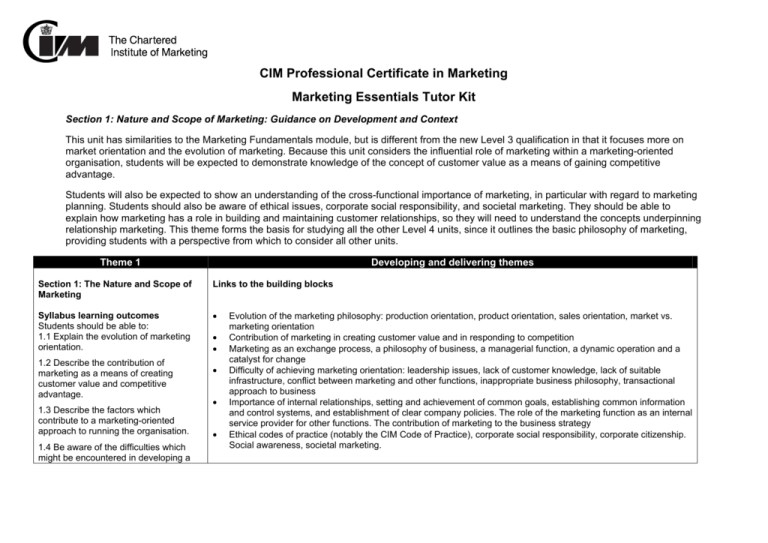CIM Professional Certificate in Marketing
advertisement

CIM Professional Certificate in Marketing Marketing Essentials Tutor Kit Section 1: Nature and Scope of Marketing: Guidance on Development and Context This unit has similarities to the Marketing Fundamentals module, but is different from the new Level 3 qualification in that it focuses more on market orientation and the evolution of marketing. Because this unit considers the influential role of marketing within a marketing-oriented organisation, students will be expected to demonstrate knowledge of the concept of customer value as a means of gaining competitive advantage. Students will also be expected to show an understanding of the cross-functional importance of marketing, in particular with regard to marketing planning. Students should also be aware of ethical issues, corporate social responsibility, and societal marketing. They should be able to explain how marketing has a role in building and maintaining customer relationships, so they will need to understand the concepts underpinning relationship marketing. This theme forms the basis for studying all the other Level 4 units, since it outlines the basic philosophy of marketing, providing students with a perspective from which to consider all other units. Theme 1 Developing and delivering themes Section 1: The Nature and Scope of Marketing Links to the building blocks Syllabus learning outcomes Students should be able to: 1.1 Explain the evolution of marketing orientation. • 1.2 Describe the contribution of marketing as a means of creating customer value and competitive advantage. 1.3 Describe the factors which contribute to a marketing-oriented approach to running the organisation. 1.4 Be aware of the difficulties which might be encountered in developing a • • • • • Evolution of the marketing philosophy: production orientation, product orientation, sales orientation, market vs. marketing orientation Contribution of marketing in creating customer value and in responding to competition Marketing as an exchange process, a philosophy of business, a managerial function, a dynamic operation and a catalyst for change Difficulty of achieving marketing orientation: leadership issues, lack of customer knowledge, lack of suitable infrastructure, conflict between marketing and other functions, inappropriate business philosophy, transactional approach to business Importance of internal relationships, setting and achievement of common goals, establishing common information and control systems, and establishment of clear company policies. The role of the marketing function as an internal service provider for other functions. The contribution of marketing to the business strategy Ethical codes of practice (notably the CIM Code of Practice), corporate social responsibility, corporate citizenship. Social awareness, societal marketing. CIM Professional Certificate in Marketing marketing orientation with the firm. 1.5 Explain the cross-functional role of marketing. 1.6 Explain the impact of marketing activities on consumers, society and the environment: marketing ethics. 1.7 Be aware of the role of relationship marketing. Directed Reading Chapter 1 of Essentials of Marketing (Blythe) Chapter 1 of Principles of Marketing (Blythe) Chapter 1 of Principles of Marketing (Brassington and Pettitt) Chapter 1 of Principles of Marketing (Kotler et al.) NB: Jobber approaches the question in a somewhat different way which does not fit the CIM syllabus. The CIM Code of Practice. Journal articles Narver, J.C. and Slater S.F. (1990): The Effects of a Market Orientation on Business Profitability. Journal of Marketing 54 (October) 20-55. Avlonitis, G. et al (1997): Marketing orientation and company performance: industrial vs. consumer goods companies. Industrial Marketing Management, 26(5) pp 385-402. Homburg, Christian: Koschate, Nicole: and Hoyer, Wayne D(2005): Do satisfied customers really pay more? A study of the relationship between customer satisfaction and willingness to pay. Journal of Marketing April vol 69 issue 2 pp 84-96. Anderson, Eugene W. Fornell, Claes: and Mazvancheryl, Sanal K. (2004): Customer Satisfaction and Shareholder Value. Journal of Marketing, vol 68 issue 4 pp 172-185. Seminar/Group Activity Ask each student to give a ten-minute presentation on the orientation of his or her own company. To what extent is customer satisfaction the driving force within the firm? To what extent would a marketing orientation improve the firm’s competitive position? Case Study Visit http://www.tescocorporate.com/page.aspx?pointerID=2D083A41E4C34AD5A6BE78EB3CF55A11 and read Marketing Essentials Tutor Kit 2 CIM Professional Certificate in Marketing Tesco’s corporate history. Now answer the following questions: 1. 2. 3. 4. 5. Websites/resources Having low costs coupled with high prices must have made Tesco very profitable in the 1950s and early 1960s. Why would Jack Cohen have lobbied for the abolition of Resale Price Maintenance? Presumably Tesco’s various customer-focused innovations cost money. Why not simply cut prices even further? Why have three separate own-brand labels? What advantages do loyalty cards have for customers and for Tesco’s? Why stock a range of organic products as well as ordinary products? www.cim.co.uk (for CIM code of practice) http://www.btplc.com/Thegroup/Regulatoryinformation/Codeofpractice/Consumercodeofpractice/ConsumerCodeofPrac tice.htm (example of a code of practice) http://www.imc.co.uk/news/professional_consultancy_article.php?item_id=427&issue=13 (articles on how marketing can be integrated into the business philosophy) Assessment support Marketing Essentials Tutor Kit Ask the students to write two short questions each (with answers separately) based on what they have learnt. Pool the questions and ask everyone to answer all the questions. 3 CIM Professional Certificate in Marketing Section 2: Planning Within the Marketing Context: Guidance on Development and Context The section on planning within the marketing context is intended to introduce students to the bigger picture of marketing. The theme should make clear to them the reasons why marketing sets objectives, why the objectives are of a particular type, and their relationship to organisational planning, activities and outputs. This theme provides students with a basis of understanding and introduces the concept of the marketing audit which will help them with the Assessing the Marketing Environment unit, where this subject will be covered in much more detail. The theme also prepares students for the Marketing Information and Research unit, since research is the basis of all planning. Theme 2 Developing and delivering themes Section 2: Planning within the marketing context Links to the building blocks Syllabus learning outcomes Students should be able to: 2.1 Explain the importance of objectives, the processes for setting them and the influences upon them. • 2.2 Identify the various possible organisational objectives. 2.3 Show how marketing planning is crucial in a market-oriented organisation. • • • • Objectives as a basis for determining future direction, consistency, motivation and measurement. SMART objectives. Internal and external influences on objective-setting. Organisational objectives are not confined to profit: sales revenue, market share, growth, technological innovation, survival, and social responsibility might also be included. Delivering strategies and achieving objectives, implementing a marketing project, monitoring and feedback, resource management, measurement of outcomes. Relationship between objectives and mission, marketing audit, setting objectives, devising strategies, marketing mix decisions, implementation, monitoring. The marketing audit as an appraisal of the internal and external environment, SWOT analysis, organisational competences and capabilities, resources versus capacity to deliver, competitor analysis. 2.4 Describe the stages of the marketing planning process. 2.5 Explain the concept of the marketing audit. Directed Reading Chapter 10 of Essentials of Marketing (Blythe) Chapter 2 and 10 of Principles of Marketing (Blythe) Chapter 21 of Principles of Marketing (Brassington and Pettitt) Chapter 3 Principles of Marketing (Kotler et al.) Marketing Essentials Tutor Kit 4 CIM Professional Certificate in Marketing Chapter 2 of Principles and Practice of Marketing (Jobber). Journal articles Chimhanzi, Jacqueline (2004): The impact of integration mechanisms on marketing/HR dynamics. Journal of Marketing Management September vol 20 issue 7/8 pp 713-740. Porter, M.E. (1990): How competitive forces shape strategy. Harvard Business Review 57 (2) pp 137-45. Seminar/Group Activity Ask each student to carry out an external environment audit for his or her own company. What are the implications of the audit? What factors do the students’ audits have in common with each other, i.e. which external environmental factors affect all companies? Case Study Visit http://www.pg.com/company/our_commitment/social_responsibility.jhtml and http://www.unilever.com/ourvalues/ and answer the following questions: 1. These two companies are clearly direct competitors. What similarities are there in their social objectives? 2. Why might companies such as these become involved in socially-valuable projects? 3. What other objectives would you expect such companies to have? 4. How might these companies set about planning to achieve their social aims? Websites/resources http://www.businessballs.com/freebusinessplansandmarketingtemplates.htm This site gives advice and a template for planning. http://www.websitemarketingplan.com/marketing_plan2.htm This website offers a wide range of articles on improving your marketing planning. http://www.bplans.co.uk/sample_plans/marketingplans.cfm This site has a large number of templates for all kinds of businesses: unfortunately it is American, which means that the plans would need considerable adaptation, but they do offer “worked examples”. Assessment support Marketing Essentials Tutor Kit Undertake assignment-based assessment type activities to help prepare for assessments 5 CIM Professional Certificate in Marketing Section 3: Guidance on development and control The marketing mix is covered in more detail at this level than at Level 3, and students will be expected to apply the theory rather than merely quote it. They should be able to describe and explain the core elements of the 7P model, and be able to evaluate the elements of the mix, explaining how each is important in differing situations. They should also be able to co-ordinate the mix, and design a coherent tactical response to specific situations. Regarding the product life cycle, students will not be expected to understand the implications on the mix for each stage of the cycle, as this will be covered at Level 6: they will only need to understand its implications as a planning tool. Pricing policies will include some consideration of the influences on pricing policies in each situation. The focus of the marketing communications taught at this level is upon developing broader and more detailed tactical responses, encompassing a greater range of communications tools than at Level 3. Students will be expected to understand the influences, power and challenges of customers when developing the marketing mix. Students will be expected to be able to explain methods for assessing the success of marketing activities for both the marketing mix and for marketing communications in particular. They would not be expected to make decisions on which assessment methods to use, but might be expected to know which measures are usually associated with each activity. Since the marketing mix is the springboard for all marketing activities, this module forms a basis for studying the remaining units. Theme 3 Developing and delivering themes Section 3: The marketing mix Links to the building blocks Syllabus learning outcomes 3.1 Students should be able to: Explain the principles of product planning. • • • • • 3.2 Explain the product life cycle. 3.3 Explain the importance of introducing new products and services. • 3.4 Explain the NPD process. • 3.5 Explain the effect of price on the • Marketing Essentials Tutor Kit Branding, product lines and ranges (depth and breadth). Packaging: design, sustainability, recycling, service support. PLC stages: development, introduction, growth, maturity, decline, obsolescence. Limitations of the PLC model. Changing customer needs, the digital revolution, long-term business strategies. NPD: Idea generation, screening, concept testing, business analysis, product development, test marketing, commercialisation and launch. Influence of price on other mix elements (sales promotion, quality surrogate, product specifications, etc.). Income, revenue and profit generation, contribution to business objectives, limitations of price as a competitive tool. Absorption costing, cost base and marginal costing, cost plus pricing, price skimming, loss-leader pricing, promotional pricing, psychological pricing. Wholesalers, retailers, agents, direct marketing, internet marketing, ending machines, telephone selling, 6 CIM Professional Certificate in Marketing other elements of the marketing mix. 3.6 Describe different pricing methods. 3.7 Define the different components of distribution channels, and show how they work together to create a distribution strategy. 3.8 Explain the factors that influence channel and distribution decisions. 3.9 Evaluate a range of marketing communication tools and consider their usefulness in different circumstances. • • • • • • franchising and licensing, digital/e-channels. Multiple channels, location of customers, compatibility, nature of goods/services, geographic/environmental issues, storage and distribution costs, import/export costs. Direct response TV advertising, personal selling, sponsorship, PR, direct marketing, sales promotions, digital technologies, website. Co-ordinated approach to people, process and physical evidence. Characteristics of services: inseparability, intangibility, variability, perishability, and non-ownership. Implications of these characteristics. Budget measurement, objectives attained, sales/revenue, profit and loss, efficiency/effectiveness, zero defects/returns, level of customer complaints, increased brand awareness, attitude change, repeat purchase and loyalty. Innovators, early adopters, early majority, late majority, laggards. Designing a mix which is internally consistent and co-ordinated effectively, considering the target market’s needs and expectations, considering competitive behaviour and response. 3.10 Evaluate the range of communications media and consider their impact in different circumstances. 3.11 Explain the contribution of people, process and physical evidence to the marketing mix. 3.12 Describe the different methods for measuring marketing outcomes. 3.13 Explain the adoption of services and products in terms of customer characteristics. 3.14 Show how a co-ordinated marketing mix contributes to customer satisfaction and competitive advantage. Directed Reading Since the marketing mix is such a large part of practical marketing, the reading tends also to be comprehensive. Chapter 1 of Essentials of Marketing (Blythe) plus chapters 6, 7 8 and 9 for more detail on the mix elements. Chapter 1 of Principles of Marketing (Blythe), with more detail in chapters 12-22. Chapters 7-19 of Principles of Marketing (Brassington and Pettitt) Marketing Essentials Tutor Kit 7 CIM Professional Certificate in Marketing Chapters 13 -22 of Principles of Marketing (Kotler et al.) Chapters 8-17 of Principles and Practice of Marketing (Jobber). Journal articles Booms, B.H.and Bitner, M.J. (1982): Marketing strategies and organisation structures for service firms. In Donnelly, J.H. and George, W.R. (eds) Marketing of services. (Chicago: American Marketing Association pp 47-52). Seminar/Group Activity Working in small groups, work out a basic marketing mix for one of the following products (each group to work on a different product). • A new theme park based on Thomas the Tank Engine. • An upmarket supermarket chain specialising in delicatessen, organic greengrocery, and high-class foodstuffs generally. • A new type of hair gel. Be as detailed as possible. Students should be able to refine the product, decide on a target market, and provide basic answers to the problem for each of the seven Ps. Case Study Visit http://www.pfizer.co.uk/default.asp Now answer the following questions: 1. How would Pfizer market a new prescription drug, given that the general public cannot buy such drugs for themselves, doctors do not stock them, and pharmacists cannot sell them? 2. What would you expect Pfizer’s NPD process to be? 3. Pfizer produce Viagra. What are the specific marketing problems you might encounter with this drug? 4. How can Pfizer best maintain competitive advantage? Website exercises/resources http://www.berr.gov.uk/index.html is the official website of the Department for Business Enterprise and Regulatory Reform. It contains a large number of articles and statistics on innovation, as well as advice for innovative businesses. www.myoffers.co.uk . This website directs users to many sales promotions, providing a useful set of examples. www.advertisingarchives.co.uk . This site contains advertisements going back over a hundred years. http://www.cbc.ca/consumers/market/files/home/failedproducts/index.html This is an article about failed products, giving some of the reasons why they fail. Marketing Essentials Tutor Kit 8 CIM Professional Certificate in Marketing http://brand.blogs.com/mantra/2005/02/lovehate_brand_.html . This is a chatroom for people to post their messages of love or hate about brands. It offers some interesting insights into what goes wrong with brand messages. Assessment support Marketing Essentials Tutor Kit Look at some of the assignment-based tasks from previous Marketing Fundamental assignments as discussion topics or individual homework activities to help prepare for case study assessments 9






